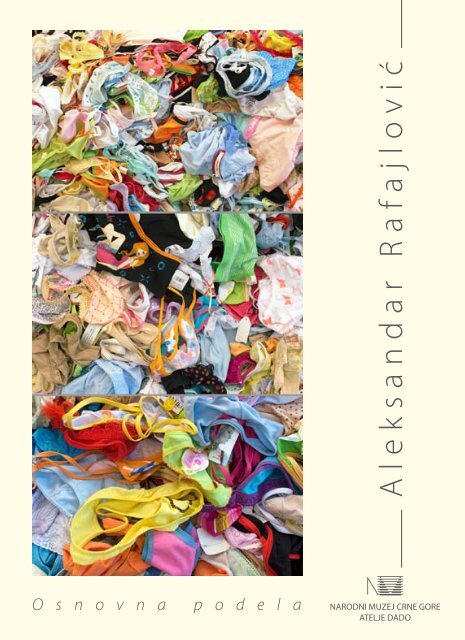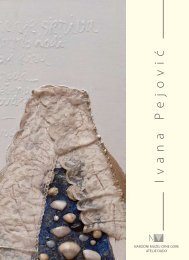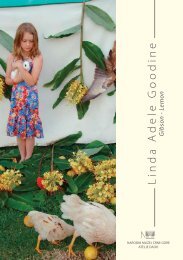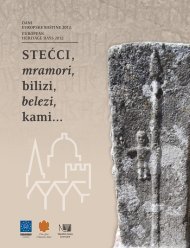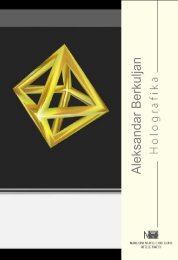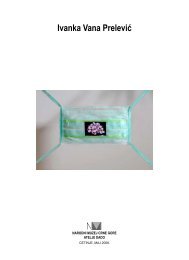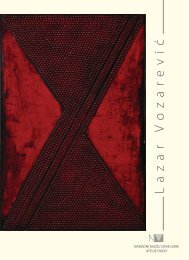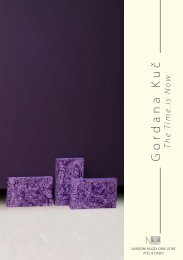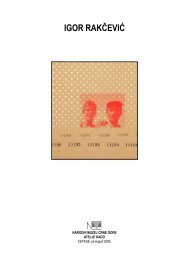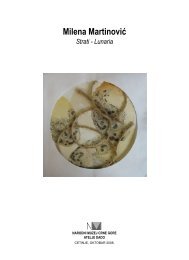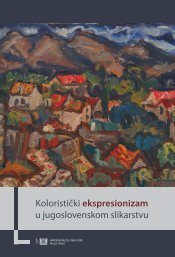Aleksandar R afajlo viÄ - Narodni muzej Crne Gore
Aleksandar R afajlo viÄ - Narodni muzej Crne Gore
Aleksandar R afajlo viÄ - Narodni muzej Crne Gore
- No tags were found...
Create successful ePaper yourself
Turn your PDF publications into a flip-book with our unique Google optimized e-Paper software.
ijalnog ustrojstva, on izdvaja one koji odgovaraju njegovoj zamisli i povezuje ih, ne po principu formalnihi kolorističkih pretapanja, već po principu vizuelnih harmoničnosti i strukturalnih logičnosti.Na izložbi u Ateljeu DADO R<strong>afajlo</strong>vić se predstavlja fotografijama, velikih formata, koje su na njegovimranijim izložbama predstavljale dio određene tematske cjeline. Međutim, svojom višeslojnomkonotacijom one se mogu objediniti u nove koncepcijske okvire.Fotografije Sezona i Ruke imaju značenje autoportreta. Umjetnikov lik transponovan je u samosvojanautobiografski sadržaj. Opiljci istrošenih olovki i ruke otvorenih dlanova, umazane bojom, atributisu slikara, neumornog i vanserijskog portretiste koji decenijama portretiše ljude u ljetovalištimaduž Jadranske obale, Portugala i Grčke.Sa izložbe Rua da Alegria - Ulica radosti koja je naziv dobila po intrigantnom tekstu ispisanomu koritu ispod grobljanske česme u portugalskom gradu Kvarteiri odabrao je nekoliko fotografija– slika iste tematske sadržine. Na ovom bijelom, hladnom i jednoličnom groblju fotografisao jedetalje: cvijeće, portrete i figurine svetaca. Tu je i Mermer, materija ispunjena staklastom hladnoćom- prefinjenih struktura, koja kao odvojen segment ne govori ništa za sebe, ali u virtuelnoj relaciji sanavedenim “dekorativnim” elementima dobija jasnu značenjsku konotaciju. Cvijeće, vještačko - plastično- grobljansko, hladno, morbidno, dugovječno, ali i koloristički raskošno, predstavlja iracionalnualternativu prirodnom cvijeću koje simbolizuje besmrtnost u odnosu na prolaznost, kratkoću života,ljepotu, zadovoljstvo. Ono prati duše umrlih do mjesta vječnog počinka i na njihovim humkamaevocira ovozemaljsku ljepotu. Portreti, porcelanski, u ramovima, ukazuju na prisustvo drugog svijeta.To su likovi podsjećanja na jedan životni trenutak uhvaćen za vječnost, i iluziju života koji se nastavljau carstvu sjeni. Fenomen smrti je dobio novi smisao kojim se pomjeraju “granice” između ovozemaljskogi carstva upokojenih. Sa fotografija Posao, statuete Hrista i Djevice Marije iz molitvenih oltara- niša ukazuju na božansku prisutnost i prenose njegovu promisao da svako od nas ima sveti posaoda se približi samom sebi, i da odgovara za sve svoje zemaljske postupke. Svjetlost - bjelina, život -smrt, prolaznost- vječnost, privatno - javno, prisutno - odsutno karakterišu ove “dekorativne” detaljesa groblja koji kao da nas opominju kroz riječi lame, geša Vengajla: Suoči se sa njima. Ne bježi. Okrenise i suoči sa njima.Tu su i fotografije Neba vertikalno okrenutog beskraju, i Zemlje naglašene horizontale, ispucale,žute, “pustinjske”, sa krhkim ćupovima i vazama sa vještačkim cvijećem, praznim, razbijenim, rasprostrtimpo tlu. One povezuju materiju i duh, konačnost i beskonačnost koja obavija transcendentalnugrobljansku atmosferu.Osjećaj prolaznosti i nestajanja nalazimo na fotografijama: Zgarišta - sa sagorjelim ugarcima irazbacanim stvarima među kojima luta napuštena mačka; i Fasada gdje neumitno vrijeme rasipa inagriza materiju.Pored navedenih fotografija koje nose poruke spiritualnog i tragičnog on fotografiše Bombonekoje evociraju slast i radosti djetinjstva; i daje na uvid žensko rublje - S M L XL koje intenzivnim bojama,šarama, dezenima, oblicima, demistifikuje tradicionalne vrijednosti i tabue erotskog i nedodirljivog- intimnog.Što nam zapravo prenosi fotografsko-slikarski svijet Aleksandra R<strong>afajlo</strong>vića? Da li je to registrovanjetrošnosti i prolaznosti organske i neorganske materije, od koje je sazdan svijet kao kosmičkai mikrokosmička kategorija, ili spoznajna antropologija, u kojoj je interesovanje istraživača okrenutoka sferi značenja i simbola. Mislim da se u R<strong>afajlo</strong>vićevom stvaralaštvu javlja i jedna i druga premisa.Zavirujući u tajne Stvarnosti on izuzetnom kreativnom snagom otkriva bljesak vječnog u svetu neprestanihpromjena.Ljiljana ZekovićCetinje, jun 2009.istoričar umjetnosti
Bombone, fotografije, 100 x 150 cm, 1999.Zgarište, fotografije, 100 x 150 cm, 1999.
Zemlja, fotografije, 75 x 150 cm, 2004.Cveće, fotografije, 250 x300 cm, 2002.
“In short, the self is a synthesis of the infinite and the finite, of the temporal and the eternal, of freedomand necessity.” (Soren Kierkegaard)<strong>Aleksandar</strong> R<strong>afajlo</strong>vić, a painter, photographer and conceptualist, is an artist of a special humanisticsensibility which does not allow him to express himself in a language of indifference and completeneutrality, but which enables him to give the content a measure of relevance depending on hisemotions and inspirational moment.In the past decade, R<strong>afajlo</strong>vić’s paintbrush has been replaced by a camera, which has changedhis means of expression but not the distinct artistic poetics characterized by a logical sequence frommimetic sensations to abstract reflectiveness. Nothing in this artist’s work is accidental. It is conceivedas an intellectual idea and an ideational construct, which seeks a higher expressional form beyondthe borders of relativity.Photographic iconography has opened the path trodden by painting to its great modern expression- abstraction, and it has an extraordinary capacity to turn its content into works of art which donot reproduce reality but process it again. “Photography as a medium is of no interest to me; I’m ratherinterested in the problem of how to make a photo into a painting. They are still paintings where photos playthe role of a palette... the final result is always a painting”, R<strong>afajlo</strong>vić points out, defining his credo.In photographs, or “photo-paintings”, the artist directs his creative energy towards discoveringthe world around him through the voice of objects which possess internal energy and optical rhythm:from those which belong to the cult of untouchable taboos and the mystery of awe, to thesimple, prosaic things in which, instead of the spiritual, he accentuates “painting” values. In his photographs,the elements of structure and colouristic orchestration of conceptual reference turn us toabstraction. This has been emphasized by the artist himself who presents his own work as “Homageto the masters of coloured field from Kandinsky to De Kooning”.Applying the total-detail principle, typical of mass visual communications, the author zooms inon monosemic objects or spaces, and in their unique symbiosis, he creates polyptychs with expressivecontent, synchronic perceptive sensations and clearly articulated formal values. His creative work,a priori, is a superstructure of the existing objects. Among an array of shots with the same content,notional and material constitution, he chooses those which suit his idea, only to link them, not onthe principle of formal and colouristic blending, but on the principle of visual harmony and structurallogic.In the exhibition at the DADO Atelier, R<strong>afajlo</strong>vić is presented with large-size photographs whichin his previous exhibitions formed part of certain thematic wholes. However, with their multi-layerconnotations, they may be united in new conceptual frameworks.Photographs The Season and Hands bear the meaning of a self-portrait. The artist’s image hasbeen transposed into an authentic and meaningful autobiographical content. The sawdust of usedup pencils and open, paint-stained hands are the attributes of a painter, a tireless and extraordinaryportraitist who has been portraying people for years in summer resorts along the Adriatic coast, inPortugal and in Greece.From the exhibition Rua da Alegria – The Street of Joy, named after an intriguing text written undera graveyard fountain in the Portuguese town of Quarteira, the artist has selected several photographs– paintings of the same thematic content. In this white, cold and monotonous graveyard, he photographeddetails: flowers, portraits and saint figures. Then there is Marble, the material filled with glassycold and characterized by subtle structures, which, taken separately, speaks nothing for itself; still, inthe virtual relation with the mentioned “decorative” elements it acquires a clear connotation. Flowers,artificial – plastic – cemetery, cold, morbid, long-lived, but at the same time luxuriant in colour, representan irrational alternative to natural flowers which symbolize immortality in relation to the ephemeralityof life, beauty, pleasure. They accompany the souls of the dead to their burial place, evoking
Posao, fotografije, 50 x 100 cm, 2004.this-worldly beauty on their grave mounds. Framed, porcelain Portraits indicate the presence of theother world. They are images which remind us of a moment in life captured for eternity, and theillusion of life which continues in the reign of shadows. The phenomenon of death has gained a newsense which shifts the “borders” between this world and the kingdom of the dead. From the photosDuty, the statuettes of Christ and the Virgin Mary from prayer altars – niches point to God’s presenceand convey his idea that all of us have a holy duty to come close to ourselves and be responsible forthis-worldly deeds. Light – whiteness, life – death, ephemerality – eternity, private – public, presence– absence characterize these “decorative” details from the graveyard which seem to warn us throughthe words of Lama Geshe Wangyal: Face it. Don’t run. Turn around and face it.Among the photographs are the Sky, vertically turned to the infinity, and the Earth, in a prominenthorizontal line, cracked, yellow, “desert-like”, with fragile pots and vases with artificial flowers,empty, broken, scattered on the ground. They connect matter and spirit, finiteness and infinity whichdominates the transcendental graveyard atmosphere.The feeling of transience and disappearance is found in the following photographs: Scene of Fire– with burnt out firebrands and scattered things with a deserted cat wandering among them; andThe Facade where relentless time eats away at matter.Apart from the above mentioned photographs carrying the messages of the spiritual and the tragic,R<strong>afajlo</strong>vić shoots Sweets evoking the joys of childhood; in addition, he portrays female underwear- S M L XL, using bold colours, patterns, designs and shapes to demystify the traditional values andtaboos of the erotic and the untouchable – the intimate.What is it that <strong>Aleksandar</strong> R<strong>afajlo</strong>vić’s work of photography and painting conveys? Is it the recordingof the ephemeral nature of organic and inorganic matter, which the world as a cosmic andmicrocosmic category is made of, or cognitive anthropology, in which the researcher’s interest is directedto the sphere of meanings and symbols? I think that Rafailović’s work contains both premises.Peeping into the secrets of Reality, with his exceptional creative power the artist reveals the flash ofthe eternal in the ever-changing world.Cetinje, June 2009Ljiljana Zekovićart historian
<strong>Aleksandar</strong> R<strong>afajlo</strong>vićRođen 1957. u Beranama, Crna Gora. Diplomirao slikarstvo na Fakultetu Likovnih umetnosti uBeogradu, 1980. Postdiplomske studije završio na istom fakultetu, 1983.Specijalizirao na École Nationale Supérieure des Beaux-Arts u Parizu, 1983/84.Dubrovačka 16, 11080 Zemun, Srbijatel +381 11 2190041, mob. tel +381 62 621747764, e-mail: vmar@eunet.yuIZABRANE SAMOSTALNE IZLOŽBE1999. Slikano mesto - Galerija Doma omladine, BeogradMemória pintada/Painted memory Galeria Praça do Mar Quarteira, Portugal2002. Ulica radosti/Rua de alegria - Salon Muzeja savremene umetnosti BeogradÀ memória de - Galerija Kulturnog centra, Beograd2004. Slikao sam Airtona Senu - Galerija ULUS, BeogradPosao/Work - Prodajna galerija ‘’Beograd’’2005. Slikao sam Airtona Senu - Muzej savremene umetnosti Republike Srpske, Banja LukaPošta - Šok galerija, Art klinika, Novi SadJedan Jedan/One one - Umetnička galerija “Nadežda Petrović”, Čačak2007. Jubilej 50 - Galerija Remont, Beograd2008. SMLXL - Galerija Artget, Beograd2009. Die grosse Arbeit des kleinen Selbst - Fortuna Galerie, Beč, AustrijaRuke,fotografije, 150 x 75 , 2004.IZABRANE GRUPNE IZLOŽBE1999. www.Blickpunt Belgrad.de - Ludvig forum fur internacionale Kunst, Ahen, Nemačka40. Oktobarski salon - Umetnički paviljon “Cvijeta Zuzorić”, Beograd2000. Od avangarde do Arkadije - Galerija Zepter, BeogradFotografisano mesto - Salon Muzeja savremene umetnosti, Beograd2001. Peti Beogradski bijenale crteža i male plastike - UP “Cvijeta Zuzorić”, Beograd2002. Remont review - Galerija Remont, Beograd2002. Salon d´Automne - Espace Auteuil, Pariz, Francuska2003. VII Prolećni anale - Dom kulture, ČačakSavremena srpska fotografija - Mesiac fotografie, Bratislava, Slovačka44. Oktobarski salon - UP “Cvijeta Zuzorić”, Beograd2005. Tačka presecanja, projekt fotografija - Galerija ULUS, BeogradViennAfair, The International Art Fair - Messzentrum Wien Neu, Beč, AustrijaO normalnosti. Umetnost u Srbiji 1989-2001 - Muzej savremene umetnosti, Beograd46.Oktobarski salon, Umetnost koja radi - Kuća legata, Beograd2006. Postcards - Salon Muzeja savremene umetnosti, Beograd2007. Biblioteka - Otvorena knjiga Balkana, knjiga kao umetnički predmet - Umjetničkagalerija Collegium Artisticum, Sarajevo, Bosna i HercegovinaCarrefour 2007 - Kulturni centar Srbije, Pariz, Francuska2008. Telenorova kolekcija savremene srpske umetnosti – UP „Cvijeta Zuzorić“, Beograd2008/09. Razotkrivanje / Disclosure / Revelation – Savremena srpska scena –Musee d’Art Moderne de Saint-Etienne Metropole – Sent Etjen, Francuska;Nacionalna galerija Makedonije / Mala stanica – Skopje; MSU Republike Srpske,Banja Luka; Arheološki <strong>muzej</strong> ( u okviru 2. Bijenala savremene umetnosti ), Solun, Grčka2009. 11th Istanbul Biennial, 2009. – parallel event - Belgrade Experience – TheOctober Salon – BMSuma -Contemporary Art Center – Istambul, TurskaNAGRADESezonafotografije, 150 x 75 , 2004.1999. Nagrada 40. Oktobarskog salona, Beograd2001. Nagrada za crtež na Petom beogradskom bijenalu crteža i plastike, Beograd2003. Nagrada VII Prolećnog anala, Čačak2003. Plaketa ULUPUDS-a na 44. Oktobarskom salonu, Beograd2005. Nagrada’’Politike’’za likovnu umetnost iz Fonda “Vladislav Ribnikar” za 2004. Beograd2005. Nagrada 46. Oktobarskog salona, BeogradIzdavač: <strong>Narodni</strong> <strong>muzej</strong> <strong>Crne</strong> <strong>Gore</strong> | Za izdavača: Pavle Pejović | Tekst: Ljiljana Zeković | Prevod : Olivera Kusovac | Dizajn i štampa: DPC | Tiraž: 300 | Cetinje, jun/jul 2009.


